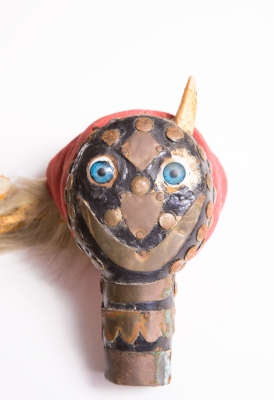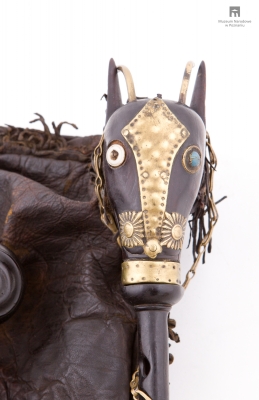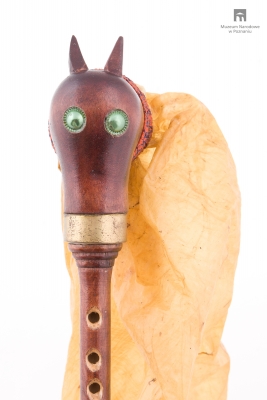About
The project was implemented by the Institute of Music and Dance in 2014 marking the Oskar Kolberg Year that celebrated the bicentenary of the prominent Polish folklorist and ethnographer. The database contains nearly 300 Polish folk instruments from across the country that are now in the custody of the Museum of Folk Musical Instruments in Szydłowiec, the State Ethnographic Museum in Warsaw, the Musical Instrument Museum and the Ethnographic Museum in Poznań (departments of the National Museum in Poznań), the Jadwiga and Marian Sobieski Collection, as well as the Municipal Museum of Żywiec – The Old Castle. On the website you will find around 1000 high quality photos and objects captured using 360 degree imaging.
Polish folk instruments and sound-making tools belong to different collections across the country, yet for reasons of proper conservation, exhibition scheduling, as well as because of limited space, they are mostly kept in museum storerooms, and are not available for viewing on an everyday basis. As the concept of norm with respect to folk instruments is labile, and can be determined only by setting different variants of instrument construction side by side, it is extremely important that a wide material for comparisons is available. The database contains most kinds of folk instruments found in Poland, their most interesting types and variants. The items date from different eras (18th-21st century) and display changes in construction and adorning that took place over time due to different factors. This allows for contrasting items built centuries ago and ones made today, e.g. as a result of folkloristic revival efforts. You will find in the database instruments that may be played today along with ones that are inoperative (their descriptions feature hypothetical assumptions on their scale or tuning).
The project presents folk instruments in a regional context, however, more research into the field is needed, and not all of the instruments have been sufficiently examined yet. More work must be put into developing a satisfactory set of terminology, unified methodology for describing the instruments, and measuring them in a standardised way. Instrument catalogue cards are based on museum index cards. The soundtracks feature generic instruments, not the specific items presented - when it comes to performing folk music, the style of playing and the musical context are of much greater significance than the way an instrument sounds. The videos present both archival performances and folk revival efforts.
The database is open, and may be gradually expanded over time to include interesting items from other collections. We will welcome any contributions to this marvellous resource. The project uses the latest version of the classification published in 1914 by Erich Moritz von Hornbostel and Curt Sachs. It was recently verified by the MIMO (Musical Instrument Museums Online) Consortium, that generously permitted us to use it in Polish translation. We hope that the resources inspire further research, and give credit to the wealth of Polish folk music and its creators' never-ending inventiveness.
Agata Mierzejewska
Project concept: Andrzej Kosowski, director of the Institute of Music and Dance in Warsaw (IMIT)
Project coordinator: Brygida Błaszczyk-Podhajska
Curator: Agata Mierzejewska
Photographs: Waldemar Kielichowski
Expert consultant, author of instrument descriptions and regions' characteristics: Professor Zbigniew J. Przerembski, University of Wrocław, Department of Musicology
Expert consultant, translator of instrument descriptions: Professor Beniamin Vogel, professor emeritus
Translation of the Hornbostel and Sachs classification: Professor Beniamin Vogel, Joanna Gul, University of Wrocław, Department of Musicology
Classification of instruments in the database: Professor Beniamin Vogel, Joanna Gul
Selection of audio and video materials: Agata Mierzejewska
Translation of historical texts: John Comber
Translation of overviews of regions' musical characteristics, descriptions of collections, and the introduction: Monika Tacikowska
Blog editor: Agata Mierzejewska
Editor of the Education section: Brygida Błaszczyk-Podhajska
360 degree photos: fp360.pl
Website design: Studio Robot
We would like to thank to the following people:
Aneta Oborny, Ph. D., director of the Museum of Folk Musical Instruments in Szydłowiec
Adam Czyżewski, Ph. D., director of the State Ethnographic Museum in Warsaw
Małgorzata Orlewicz, deputy director of the State Ethnographic Museum in Warsaw
Professor Wojciech Suchocki, director of the National Museum in Poznań
Janusz Jaskulski, curator of the Musical Instrument Museum, department of the National Museum in Poznań
Aneta Skibińska, curator of the Ethnographic Museum, department of the National Museum in Poznań
Joanna Sobieska
Wioleta Wnorowska
Klara Sielicka-Baryłka, State Ethnographic Museum in Warsaw
Katarzyna Zedel, Museum of Folk Musical Instruments in Szydłowiec
Elwira Sobiak, Ethnographic Museum, department of the National Museum in Poznań
Jacek Jackowski, head of Phonographic Collections, Institute of Art, Polish Academy of Sciences
Piotr Dorosz, Institute of Art, Polish Academy of Sciences
Anna Rutkowska, Institute of Art, Polish Academy of Sciences
Maciej Królikowski, Institute of Art, Polish Academy of Sciences
Paweł Heppner, Muzeum Dźwięku [Museum of Sound] (instrumentyludowe.pl)
Norman Rodger, MIMO - Musical Instrument Museums Online Project Manager
Barbara Rosiek, Municipal Museum of Żywiec – The Old Castle
Collections:
Museum of Folk Musical Instruments in Szydłowiec (MLIM)
State Ethnographic Museum in Warsaw (PME)
Musical Instrument Museum, department of the National Museum in Poznań (MNP I)
Ethnographic Museum, department of the National Museum in Poznań (MNP E)
Jadwiga and Marian Sobieski Collection (S)
Municipal Museum of Żywiec - The Old Castle (MŻ-E)
Audio and video recordings:
Sources of Polish Folk Music. Polish Radio and Institute of Music and Dance Collection
Institute of Music and Dance (IMIT)
Institute of Art of the Polish Academy of Sciences (ISPAN)
Fryderyk Chopin Institute (NIFC)
Muzyka Odnaleziona [Music Lost&Found] (muzykaodnaleziona.pl)
Muzeum Dźwięku [Museum of Sound] (instrumentyludowe.pl)
Zamek Cieszyn
Maciej Stasiński (www.watra.pl)
Financed by the Ministry of Culture and National Heritage of Poland as a key project to mark the Kolberg Year.












